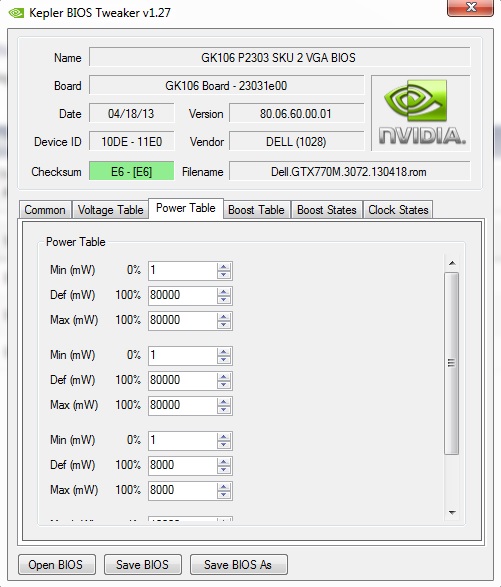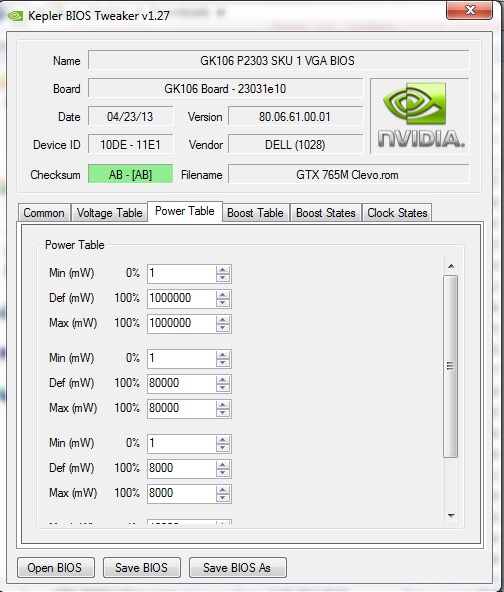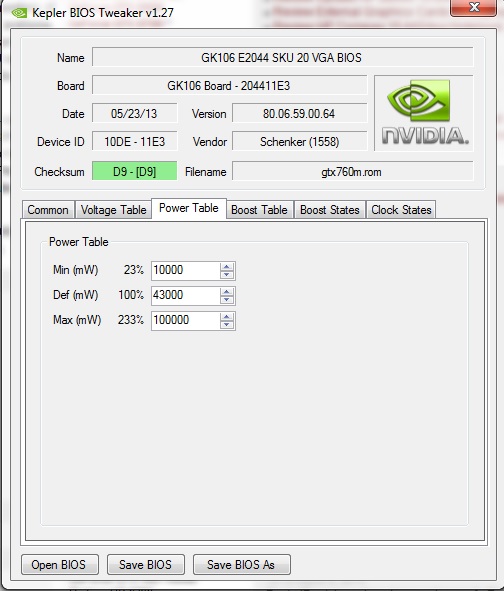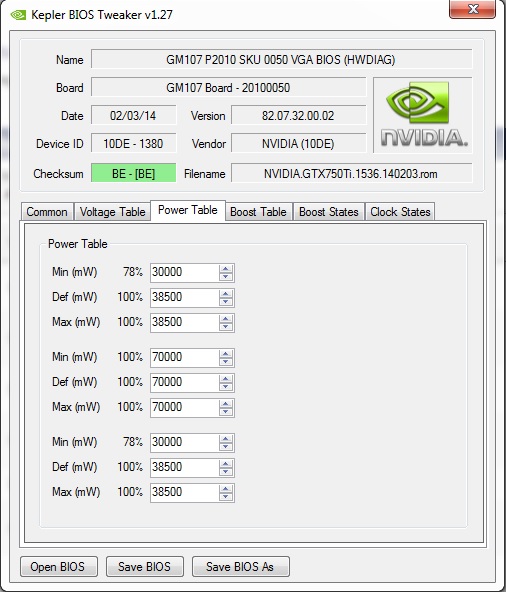That is some impressive performance from a mid-range card. I don't think we've seen that sort of jump since G70/NV47 to G80, and certainly never without a die shrink. It's no wonder nV is sitting on their high-end chips at 20nm until later this year -- otherwise they'd obliterate their GK104 sales.
I can't wait to see what the top-end Maxwells can do.
-
900Mhz P5300 => +135MHz will give us P6000
 This card is just a monster, i just regret a little the 128bit bus.. BUT with high voltage memory, some OC may cover up the nasty little bus
This card is just a monster, i just regret a little the 128bit bus.. BUT with high voltage memory, some OC may cover up the nasty little bus
 Cloudfire likes this.
Cloudfire likes this. -
The good thing is that GTX 860M seems to have high voltage VRAM aka desktop VRAM so you should be able to overclock that VRAM to get higher bandwidth

Plus we must remember that GTX 860M also have 8x more L2 cache than GTX 660M, which according to Anandtech should give it similar bandwidth as 192bit.
Me too. We saw around 80% better performance with GTX 680M vs 580M. This GTX 860M looks to have around 120% better performance than 660M. In benchmarks, hopefully the same in games too sasuke256 likes this.
sasuke256 likes this. -
ThePerfectStorm Notebook Deity
NVIDIA GeForce 860M Laptop Maxwell GPU Benchmarks Appear
Backing up Cloudfire.Cloudfire likes this. -
Guys I do not understand where the 900 mhz are coming from . It says GPU clock speed: 540mhz?
-
Something funny is happening in my pants right now...
-
See post #399 on previous page.
The mobile counterpart of the desktop version are usually "cutdown" a bit aren't they? Even if that's the case an overclocked score of say...5450 still sounds great! -
GTX 750 Ti: 640 cores running at 1085MHz scores around 5750 in 3DMark11
GTX 860M: 640 cores running at ?MHz scores around 5150 in 3DMark11.
It score less so I think its running at slower clocks than 750 Ti. I think its more like 900MHz to score 5150.
If it ran at 500MHz it would score way lower than 5150 in 3DMark11.
Do you mean the chip? Its a full GM107 without any parts cut (Same ROPs, bandwidth, cores etc).
Thanks. Its all over internet now. ooops, Nvidia is probably not happy BlackSabs likes this.
BlackSabs likes this. -
Wccftech actually cited this forum for their info.
That's shameless. -
You guys are comparing the 860M to the 660M? Why?
Compare it to the 760M or the 765M at least.
The increase is another 25% over the 765M 3DMark 11 GPU score (4100ish). -
It's probably because of the architecture change from Kepler to Maxwell. The 660M -> 760M was a Kepler to Kepler. The same could be said about the change from Fermi to Kepler 460M to 660M.
-
they are comparing 1st gen maxwell vs 1st gen Kepler
 Cloudfire likes this.
Cloudfire likes this. -
I agree with the two above.
GTX 660M was the first Kepler. GTX 860M is the first Maxwell.
We can compare GTX 760M with GTX 960M when it arrives.
Isnt that impressive? A 45W Maxwell beating a 70W Kepler by 20-30%?
I bet AORUS feel silly now...hailgod likes this. -
Guys I really need your help here. I am an old school-er who uses Windows XP, so I can not deal with Windows 8.So I am looking for a laptop with windows 7,MSI laptops released the windows 7 version 2 months after the new cards were released.Is there anyway I can get windows 7 on an 860 laptop without using sager or clevo because I have never used any of them before, without waiting 2 months for msi and I would like to buy the laptop from amazon
-
Meaker@Sager Company Representative
It's not really fair to compare to the 660M as really that was just an overclocked 650M and should have been called the GT 655M (no GTX, just GT) as it's performance was sub par for the generation.
octiceps likes this. -
You would most likely need to buy a OEM copy of Windows 7 (serial key) and do a full format of the hard drive, so you'll have an extra expense. Having had Win 8.1 forced upon me at work, honestly, I don't really have a problem with it compared to Windows 7. Just takes a couple of days to get used to. Some re-sellers will give you the option to select an OS as well.
-
Win 8.1 isn't horrible with third party apps to make it more Win 7-ish. I just wouldn't buy it if already have Win 7 honestly.
-
Comparing the 860m to a 2 gen old chip rather than the chip that it's supposed to replace really makes no sense. What does that even accomplish?
When the 780m was released, I remember that we were all adding up all the numbers from the notebookcheck review to see how much faster it was than the 680m, not the 580m. -
Guys correct me if I am wrong, a gtx 860 has a 3d mark 11 of 5157 nearly=GTX 770
GTX 770+15%=GTX 680 meaning GTX 860+ GPU BOOST (15%)=GTX 680
If the above is correct then how come GTX 860 is only 20%+15% (35%) higher than 765
and GTX 680=765 SLI=765+80%
Question is how come 680 (860+15%) is 765 SLI when 860(+15%)=765 +35%
Sorry if I complicated it lol -
Because
A) GTX 770M/760M is midrange GK106, GTX 860M is low end GM107. GTX 660M is low end Kepler GK107.
B) GTX 770M TDP of 80W. GTX 760M 65-70W. GTX 860M TDP 45W. GTX 660M 45W.
We compared GTX 580M with GTX 680M because both had 100W TDP and both were high end.
I don`t know about the rest, but I compared GTX 680M and GTX 780M to figure out how much faster it was
But go ahead, nobody is stopping you from comparing 860M and GTX 760M. I`m more interested to see how much more efficient Maxwell is, and that is much easier when TDP is the same and they are both low
end. In the end you find same TDP GPUs in the same notebook size too. You may not find a 70W GTX 760M inside a superthin Asus notebook, but you could find both 45W GTX 660M and 45W GTX 860M there. ie replacement.
GT 840M - GM107
GT 845M - GM107
GTX 850M - GM107
GTX 860M - GM107
Like this time will be different
Low end is low end Meaker. Just because they couldnt build faster low end Kepler at that time, its still a highly valid comparison.
GTX 765M SLI score 8000 in 3DMark11. GTX 680M is at 6000.
If you overclock that GTX 860M to 1200MHz, you will actually score the same as a GTX 680M. Imagine that, low end Maxwell can reach high end Kepler with some overclocking hailgod likes this.
hailgod likes this. -
Where are you getting these TDPs from? Notebookcheck and TPU both put the 760m at 55W. TPU and Cloudfire put the 660m at 50W and 75W respectively.
If you look at the TDPs for the 660m and the 760m, you'll see that the 760m is considerably more efficient. Does this mean that Nvidia greatly improved the uarch between the 760m and 660m? No, the 760m just has better binning and is on a much more mature 28nm process. Which is also why if you want to see how much more efficient Maxwell is than Kepler, comparing the 860m to the 660m is flawed. You'd do best to use the 760m, which is on even ground wth the 860m process wise.
Also, notebooks with the 660m had no problem upgrading to the 760m. Heck, notebooks like the MSI GE60 and Clevo W350et/st went from a 660m to a 765m. Which 'superthin' Asus notebook had a 45W GTX660? -
I think it's best to compare TDP to TDP. That's the true measure of performance improvement. 765m is at least 60W, likely 65W TDP. If they can exceed 765m by 15-20% at 20W less TDP that is very impressive. A 65W TDP chip should run at least 50% faster than the 765m then.
-
ThePerfectStorm Notebook Deity
If this is true, think what a 100W Maxwell chip will perform like - Even the 75-80W Maxwell should crush the GTX 780M.
Cloudfire likes this.
- Even the 75-80W Maxwell should crush the GTX 780M.
Cloudfire likes this. -
I think HTWingNut gets it right.
TDP will probably be the limitation regarding what notebooks end up taking these GPUs and what characteristics they have (general size and thinness, for example). Maybe we'll see a healthy boost in graphics performance all across the board .
Cloudfire likes this.
.
Cloudfire likes this. -
ThePerfectStorm Notebook Deity
Based on these benchmarks, we should definitely see a big boost in graphics performance across the board. -
We have to see yet, if it is really has only 40W TDP, than even nice fit for some more advanced 14" ultrbaooks too, like the MSI GE40, Gigabyte P34G or the U24F.
-
TDP of the GTX 860M is definitely impressive for its performance.
But just ok when you compare the stock performance to a previous kepler mid-end GTX 765M.
So, having a GTX 860M on a laptop that previously had a GTX 765M is just ok. Good to have but not great.
Still gonna wait for a 60W-65W mobile Maxwell.
GTX 860M should be focusing more on those type of laptop that can only previously go with GT 750M.
Edit :
But if the GTX 860M is a highly OCable card, then it might change the game.
OC as high or higher than a GTX 680M performance. -
The 765M isn't a 70w GPU. It's rated at 55w.
I see the point comparing the two first gen GPUs, but really, that's not what people are going to compare it to. People didn't compare the GTX 480 to the GTX 680 did they? No, they compared the vastly superior GTX 580 to the GTX 680. The main reason was to see if it was worth upgrading to in the long run. For desktop users, it certainly was due to the lower power consumption and higher performance that kepler offered, but for the laptop side of things, I can't see going from a 765M to a 860M as a viable choice. SLI 765Ms like in the Aorus X7 are still going to perform pretty well for a while... -
techpowerup, gpuboss and futuremark says that 765m has a tdp of 75w. Notebookcheck says its 60-65w. Where did you get your information of it being 55w?
Cloudfire likes this. -
Cloudfire, I have done some more calculations on your work to see how well a stock 860 with GPU boost 2.0 can perform.
If GPU boost increases 3D mark itself by 15%, we get 5930 score just below a 680
but GPU boost is more clock oriented so based on the desktop score of 5700 and its clocks and the 5157 score,I ended up with 860 clocked at 986 mhz in order to achieve that score +15%=1133mhz,this score translates into 5924mhz once more but if your 900 mhz is more accurate then the score would be 5412 at 1035mhz
Summary(My Conclusion):Gtx 860 with GPU boost results in 3d mark of 5412-5924. what is your opinion cloud -
I say we just wait a week and find out.
Killerinstinct and Amal77 like this. -
I am not a cloudfire but I decided to put my 2 cents because I'm tired of reading smth which makes me do facepalms.
Whole idea of "stock 3dmark score gives 5xxx points so with TB 2.0 it gonna be 59xx" is a bull-cr@p! Just because GPU boost is already built in graphics card and was already token into account by 3d mark software!!!!!!
So please stop doing silly speculations and move on to the side of not-so-silly speculations about how can 860m reach stock 680m by manual overclocking through MSI afterburner or Nvidia Inspector.
Thank you.Cloudfire likes this. -
Thats a solid argument, I never knew 3d mark takes into consideration the GPU boost 2.0 but I am only heavily speculating because an 860 laptop with 8 gbs of ram and 750 gb rpm (ge 60) will probably be listed at 1299 , a gtx 680 laptop with similar specs I can buy for a similar price but used of course, I am just trying to figure out which one to go for, the only problem is the gtx 680 laptop from msi comes in windows 8 and the 860 laptop may come with windows 7 at some point... What you think James? buy 680 in w8 or wait for 860 and hope msi releases in windows 7?Novaguy likes this.
-
gtx 860m has way lower power consumption than a gtx 680m. Windows 8 is better than windows 7 in every way except for their "Modern UI" which can be fixed by a program like classic shell.
Cloudfire likes this. -
Sigh.
People, you need to be more critical about what you guys read.
As for Notebookcheck and TechPowerup, they post very inaccurate TDP ratings. Nvidia doesn`t post TDP of mobile chips, they do this on the desktop chips. Then its up to us to find TDP ratings based on voltage, binning, clocks, disabled units etc.
Lets take it from the start:
Desktop GT 640 - GK107
384 cores @ 950MHz.
TDP 65W
Mobile GTX 660M - GK107
384 cores @ 835MHz
TDP 45W.
The cores run 115MHz lower, the cores run at lower voltage. A reduction from 65W > 45W (-30%) seems plausible.
Desktop GTX 650 Ti - GK106
768 cores @ 928MHz
TDP 110W
Mobile GTX 765M - GK106
768 cores @ 863MHz
TDP ?
The cores are only running 65MHz lower than GTX 650 Ti. Same amount of cores.
The GTX 660M got a 30% reduction in TDP compared to the desktop version. It was 115Mhz lower, not 65Mhz lower.
But to make it easier, say it get a 30% reduction here as well.
That will put the GTX 765M TDP at 77W. Or 75W like I think it is.
That will put GTX 760M at maybe 65-70W like I wrote since its have exact same core count as GTX 765M but running at 720MHz.
Maxwell is of course no different:
GTX 750 Ti - GM107
640 cores @ 1080MHz
TDP 60W
GTX 860M - GM107
640 cores @ 900MHz (My prediction)
TDP (60W - 30% =) 42Wdeadsmiley, Atom Ant, gust0007750 and 1 other person like this. -
ThePerfectStorm Notebook Deity
Makes sense. Even if its only bloody 55W (which we pretty much know it isn't), 20-30% increase for 10W is brilliant, at least in my books. If its close to 60-70W (as it probably is), the performance per watt is amazing.Cloudfire likes this. -
Yeah no matter which GPUs you compare with, Maxwell is clearly much much more efficient than Kepler
ThePerfectStorm and hailgod like this. -
The 2x performance per watt they advertised was not just for show. Its real. 20nm maxwell would be a lot better than 28nm kepler
-
Anything new on the 840M/845M and their performance comparisons with a 660M/740M/750M/755M? Still wondering if I should be waiting for that 13-14 inch laptop with one of those (840/5) cards
 ThePerfectStorm likes this.
ThePerfectStorm likes this. -
I may be wrong here but I think Dell (Alienware) is the only notebook OEM that offer the customers a choice between Windows 7 or Windows 8. You can downgrade Windows 8 to Windows 7 if you want, but Microsoft only allow PRO/Enterprise versions of Win8 to do that.
If you are interested in MSI notebooks with Maxwell, here are a few:
GE70 with GTX 860M. $1300
GE70 with GTX 850M. $1100
GS60 Ghost with GTX 860M. $1700
GE60 with GTX 860M. $1200
I believe there is a 13" Clevo notebook coming out with GTX 860M if you are interested. Can`t remember the name. Might check out Clevo forum -
You realize that you can just dump the power settings from the VBIOS instead of doing all these calculations, right?
Boom, power target range. Nominal (i.e. stock) TDP is 60000mW = 60W. Go find a 765m vbios and check it yourself if you don't believe me. Needless to say, it is very likely that the 760m has a lower TDP.
But go ahead, ignore the differences in binning and board power and keep making up numbers.
"The cores are only running 65MHz lower than GTX 650 Ti. Same amount of cores.
The GTX 660M got a 30% reduction in TDP compared to the desktop version. It was 115Mhz lower, not 65Mhz lower.
But to make it easier, say it get a 30% reduction here as well."
What you're doing is pretty much the reason why nobody pays attention to wccftech and similar sites. Because they just 'logic' some random numbers out of previously known facts and post things that seem like they might be true.
I'm not even going to go into the "People, you need to be more critical about what you guys read." statement, because that is just the definition of irony.
Anyway, you were right about one thing -- TPU does have misleading TDP numbers, since they listed the 765m with a higher TDP than it should be.Karamazovmm and octiceps like this. -
Killerinstinct Notebook Evangelist
I cant wait to see 11~13K 3dmark11 scores for the gtx 880MX or 885M scores (I hope ) ...
Sent from my LG-D800 using Tapatalk -
Here is my story of frustration:I want to buy a W7 laptop with high performance "GTX" "I7" at an affordable price but the problem is alienware, the only one currently supporting W7 has to offer an I5 with a gtx or an i7 with a gt. They are brilliant its either they bottleneck your processor or your GPU in the alien 14 so I am forced to consider the alien 17 but it starts at 1500 so now I pay 1500 and probably more for 8 gbs of ram and an 860, the same money that can buys me a 680 with more ram and a BD player...Its either that or I buy a 765 for 1200 with w7 and miss out on mxwell...Is there a case where I can win this? (i7 gtx+w7+maxwell)?
-
Why not go with a Clevo? Knock $1000 of your cost and get Win 7 too!
-
Actually I am spot on with my TDP information.
First up, GTX 770M.
You will notice that it have a power target of max 80W. Unlike your 765M vbios dump, it only list "100%".

Here is a GTX 765M Vbios from a Clevo card. Notice it goes all the way up to 80W? Unlike the Dell dump you posted, this have a power cap at 80W. I think one should mention that we are talking POWER here and not TDP.

Now to fully discredit your rant, here is GTX 760M.

According to your logic, based on this screenshot, GTX 760M have a TDP of 43W.
GTX 660M: 384 cores @ 719MHz = 45W
GTX 760M: 768 cores @ 657MHz = 43W
Whatever you are smoking, you should mail me some because obviously you are tripping bigtime.
Your magical binning and mature 28nm process is one thing, which you even cant back up with anything, but DOUBLING the cores and going down in TDP with the exact same architecture is just funny.
I however think that the vbios dumps that shows 43W as 100% but also list 100W as "233%", means it may allow the card to draw up to 100W. But of course in the end the clocks control the TDP, so the real TDP is somewhere between 43W and 100W. I may be in deep water here, but that is what I get from all of this.
For good measure, here is GTX 750 Ti. It does NOT have a TDP of 70W. It is 60W.

tl;dr:
GTX 770M: Still TDP around 80W
GTX 760M: Way higher than 43W. lol
GTX 765M: Somewhere between 60-100W, more toward 80W like the 765M I posted. Say 70W.
Wether you like it or not, my assumptions based on calculations of the desktop cards may be spot on.ThePerfectStorm and hailgod like this. -
Meaker@Sager Company Representative
Sager/clevo machines can come with either OS too. -
Ah ok. nice that more companies does offer a choice between the two.
-
ThePerfectStorm Notebook Deity
Tarchas, check this out - Two New ASUS Zenbook Ultrabooks On The Way | NextPowerUp
That might interest you.Atom Ant likes this. -
I understand your frustration. I've done an image backup of my current Windows 7 setup and plan on migrating it to the MSI GS60 when I purchase it. I just hope they come out with compatible drivers on release, it took a while before Windows 7 drivers were available for the GS70...
-
You seem to have a couple misconceptions, so I'll try to clear them up:
1. A Nvidia GPU will not draw more power than the power limit (not power target, my mistake for confusing the two). From the Nvidia SMI documentation:
The min/default/max definitions correspond to the same labels as in the Kepler BIOS Tweaker. Note that much of the API is not exposed to consumer GPUs (I checked with my 770m), but the Kepler BIOS Tweaker parses through the vbios dump so it doesn't need to be.
As you can see, the max power limit is something that has to be applied by the user and is not something that the GPU will reach on its own. Also, if you check against GPUs with known TDPs (e.g. GTX780ti, GTX770, etc.), you'll see that the TDPs match up almost perfectly with the default power limits. So kudos on finding a 760m vbios, the TDP of that card (or that particular variant) is 43W give or take a few watts. Maybe it doesn't make any intuitive sense to you, but the card will not go past the power limit, as per the Nvidia documentation.
Same goes for the 765m. I suspect that the "Clevo" (actually a Dell MXM card) 765m that you found is 80W because it's MXM instead of being soldered like the 60W ASUS, MSI and non-MXM Dell models. But I'll concede that I jumped the gun in concluding that the 765m is 60W.
Also, the Kepler BIOS Tweaker probably doesn't read the Maxwell 750ti correctly because, well, it's the Kepler BIOS Tweaker.
2. I can very well back up the "magical binning and mature 28nm process". But don't listen to me, listen to Nvidia. From Anandtech:
There you go. Maxwell is on a better optimized 28nm process than the first Kepler chips. Not that this is anything unusual-- Intel regularly releases higher clocked versions of their chips on the same node as their process gets better over time.
Don't get me wrong, I appreciate all the news that you post. But sometimes your analysis just makes no sense to me.
New details about Nvidia`s Maxwell
Discussion in 'Gaming (Software and Graphics Cards)' started by Cloudfire, Feb 12, 2014.